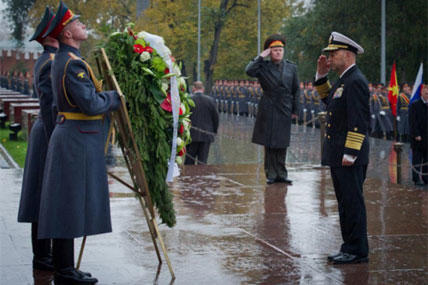Russia's invasion of Ukraine and annexation of Crimea has halted the military-to-military programs the U.S. has established with its former Cold War enemy and put the future of this improved relationship at risk.
Since the end of the Cold War, the U.S. and Russia have established numerous ground, naval and air exercises.
"They were quite numerous, up to 50 [military-to-military] events per year at some points. Some small, some large," said Dmitry Gorenburg of the strategic studies division of the CNA Corp., a non-profit think tank.
Pentagon Press Secretary Navy Rear Adm. John Kirby said on March 3 that the DoD valued the military-to-military relationship with Russia, which is designed to increase transparency, build understanding and reduce the risk of military miscalculation.
But it would not be business as usual until the Ukraine crisis is resolved, according to Kirby. It's unclear when that will happen as Russia has given no sign it plans to remove troops from Crimea.
Among the larger exercises whose futures are uncertain are FRUKUS – a naval exercise that includes France, Russia, Britain and the U.S. The four countries' ships take part in search and rescue and humanitarian relief exercises as well as roundtable naval strategy discussions.
Atlas Vision, a U.S-Russian brigade-level ground exercise at the Joint Multinational Training Command facilities in Grafenwoehr, Germany is also at risk. This exercise is designed to promote military interoperability in areas where the two countries share interests to include peacekeeping, crisis-response, and illegal weapons trafficking, U.S. Army officials said.
In the air, American and Russian pilots and aircrews held the third Vigilant Eagle Exercise in 2013 with members of the North American Aerospace Defense Command and the Russian Federation Air Force training to respond to aircraft hijackings.
This isn't the first time these exercises have been put on hold. In 2008, when Russia sent troops into the South Ossetia region of Georgia, the U.S. pulled the plug on all U.S.-Russian military-to-military programs.
After the brief Russia-Georgia war over South Ossetia in 2008, U.S.-Russian military exercises and conferences resumed in 2009.
In addition to military exercises, U.S. and Russia's military leaders have established programs to build deeper cooperation. These also have been stopped.
Last year, U.S. and Russian senior officers held talks on Afghanistan and Pakistan, according to the State Department, which has listed a number of such programs going back to 2010. Others included American participation in a nuclear security exercise at the Abramovo Counter Terrorism Training Center in Russia – itself a follow-up to Crimson Rider, a program hosted by the U.S. in 2011.
High level meetings have also been held between the U.S. and Russian navies to discuss the U.S. pivot to Asia, operations in the Arctic, non-commissioned officer development and more.
In 2012 Russian and American soldiers trained together in mountaineering, marksmanship, parachute jumps, communications and medical evacuations at Fort Carson, Colo.
U.S. officials often cite the personal relationships that are established during these exercises and meetings with their Russian counterparts. However, Gorenburg cautioned that those relationships rarely influence diplomatic decisions.
"I think there is some benefit at the operational level in terms of people getting used to working together and having some familiarity with each other," he said. "But I'm not sure it has much of an impact on political dialogue and diplomacy, as the tone for those is set by the politicians and senior military officials, rather than the people participating on the ground."
-- Bryant Jordan can be reach at bryant.jordan@monster.com




























